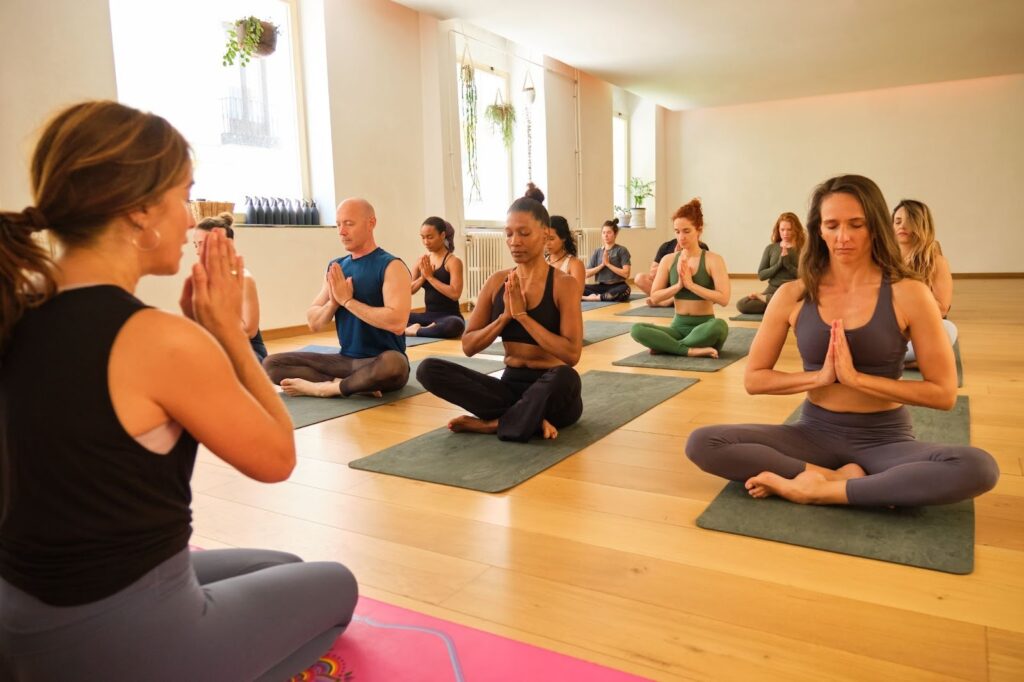Yoga today is often viewed as a workout for flexibility and fitness, yet its essence extends far deeper than physical movement. It is a centuries-old philosophy designed to align the body, mind, and consciousness. Beyond its poses, yoga represents awareness, discipline, and the pursuit of balance in life. Its purpose is not to perfect the posture but to cultivate peace and clarity from within.
The True Meaning of Yoga
Yoga means “union” in Sanskrit, symbolizing the integration of mind, body, and spirit. It guides practitioners toward awareness of their actions, thoughts, and emotions. When understood this way, yoga becomes a living philosophy rather than an exercise routine. This deeper awareness forms the foundation for personal growth and emotional balance.
Yoga as Union and Self-Realization
Yoga is designed to unite the individual self with universal consciousness. This union happens through consistent practice that connects intention, breath, and movement. When one practices with awareness, yoga becomes a tool for discovering inner truth. The goal is self-realization, where clarity replaces confusion and peace replaces struggle. This understanding leads to balance in daily choices, relationships, and responsibilities.
The Ancient Roots of Yoga Philosophy
Yoga originated in ancient India and was first recorded in the Rig Veda before evolving through the Upanishads and Bhagavad Gita. Early yogis developed it as a path toward liberation, known as moksha, achieved through discipline and self-awareness. These teachings highlight yoga’s dual nature, as it is both spiritual and practical in nature. Ancient philosophy viewed yoga as the study of the mind, not only the movement of the body. Today, this wisdom continues to shape modern approaches to mindfulness and well-being.
The Eight Limbs of Yoga Philosophy
The Yoga Sutras of Patanjali describe the Eight Limbs of Yoga as a structured path to freedom. Each limb represents a stage of development, guiding individuals from ethical living to spiritual insight. This framework includes physical, mental, and moral principles that support a balanced life. It offers a roadmap for self-discipline and inner peace.
The Moral Foundation: Yamas and Niyamas
Yamas and Niyamas are the ethical codes that shape a yogic lifestyle. Yamas teach restraint and compassion toward others through values like truth, honesty, and nonviolence. Niyamas promote personal discipline through purity, contentment, and self-reflection. Together, they nurture integrity and purpose in both thought and action. These principles provide the moral foundation for more advanced stages of yoga practice.
Physical and Mental Practices: Asana and Pranayama
Asanas are the physical postures that strengthen and prepare the body for meditation. They build flexibility, stability, and awareness while teaching patience and discipline. Pranayama, or breath control, complements movement by calming the mind and regulating the flow of energy. Conscious breathing links the physical and mental states, creating focus and clarity. Combined, these practices form the bridge between external activity and internal stillness.
The Path Inward: Pratyahara to Samadhi
The final limbs of yoga shift the focus inward from the senses to consciousness. Pratyahara teaches the withdrawal from distractions, allowing for a deeper observation of thoughts. Dharana and Dhyana develop focus and meditation, training the mind to remain steady. The culmination, Samadhi, represents complete unity—an experience of oneness beyond thought. These stages reflect yoga’s purpose: to move from outer awareness to inner peace.
Integrating the Eight Limbs in Modern Life
In modern practice, these eight limbs can guide daily living beyond the studio. Acts of kindness, mindful breathing, and meditation bring yoga’s ethics into ordinary routines. Practicing awareness during meals, work, or conversation aligns with ancient teachings. Yoga becomes not a hobby but a way of being. This integration connects philosophy with everyday wellness and personal development.

Yoga and the Mind
Yoga serves as both a mental discipline and a method of emotional regulation. It helps quiet inner restlessness by fostering focus and awareness. Through consistent practice, thoughts become organized rather than overwhelming. The stillness created by yoga nurtures clarity, patience, and resilience.
Understanding the Chitta: The Restless Mind
Patanjali described the mind as chitta, a constantly shifting and unstable entity. These fluctuations, known as vrittis, create distraction and emotional imbalance. Yoga aims to calm these movements through meditation, breath control, and awareness. By learning to observe thoughts without attachment, one regains control over emotions. This practice enhances mental stability and inner clarity.
Meditation and the Pursuit of Stillness
Meditation is the essence of yoga’s mental training, teaching stillness through focused attention and concentration. By observing the mind without reaction, awareness deepens and mental clutter dissolves. Regular meditation promotes emotional balance and self-understanding. It creates a space of calm, even during stress or uncertainty. With time, meditation turns awareness into a steady state of presence.
The Role of Breath in Mental Control
Breath connects the body and mind through rhythm and awareness. Controlled breathing reduces stress, improves concentration, and restores balance to the nervous system. When breath and thought align, calm naturally follows. Breath awareness becomes a practical tool for managing anxiety and focus. In yoga, every inhalation and exhalation becomes an opportunity for mindfulness.
Yoga as a Way of Life
Yoga’s philosophy extends beyond the mat into every part of daily life. It shapes decisions, values, and relationships through conscious awareness. Living yoga means aligning one’s actions with clarity and compassion. This mindful approach transforms ordinary moments into expressions of balance and purpose.
The Philosophy of Balance and Detachment
The Bhagavad Gita teaches acting with intention but without attachment to outcomes. Detachment does not mean withdrawal; it means freedom from emotional extremes. Yoga encourages full engagement in life while maintaining inner calm. This perspective reduces stress and promotes mental clarity. It turns effort into mindful action rather than reactive striving.
Compassion, Nonviolence, and Conscious Living
Ahimsa, or nonviolence, is the foundation of all yogic ethics. It calls for compassion toward oneself, others, and the planet. Living by this principle involves mindful eating, gentle communication, and adopting sustainable habits. It turns kindness into an everyday practice rather than an ideal. This mindset encourages respect for all forms of life, fostering collective well-being.
Discipline and Self-Awareness in Daily Life
Proper discipline in yoga is about consistency, not control. Through regular habits like meditation and reflection, awareness deepens naturally. This self-awareness helps one recognize habits and thoughts that hinder peace. Discipline keeps the practice steady, especially when life feels uncertain. Over time, it cultivates confidence, patience, and a sense of balance.

The Modern Misunderstanding of Yoga
Modern culture often limits yoga to flexibility or aesthetics. Social media and commercialization have redefined yoga as performance rather than practice. While physical fitness is a benefit, it is not the primary goal of yoga. Reconnecting with its roots restores its authenticity and purpose.
From Spiritual Discipline to Fitness Trend
In the West, yoga has become widely popular but partially misunderstood. Many studios emphasize physical form over mental and spiritual awareness. This shift has made yoga accessible, but it is often shallow in meaning. True yoga was never about physical perfection but about inner stillness. Reclaiming its philosophical foundation gives modern practitioners a more profound sense of fulfillment.
Reclaiming Authentic Yoga in Modern Times
Educators and traditional schools are reviving authentic yoga practices that honor their origins. They combine philosophy, meditation, and ethics with movement-based instruction. This balance reconnects practitioners to yoga’s spiritual depth while remaining relevant in today’s world. Workshops and teacher training now emphasize mindfulness over mere flexibility. Such approaches bring yoga closer to its original purpose—union through awareness.
The Impact of Commercialization on Yoga
Commercial trends have transformed yoga into a global industry, often obscuring its core philosophy. Designer mats, branded studios, and online influencers promote image over substance. However, a growing community is pushing back by promoting authenticity and education. Teachers now emphasize accessibility, ethics, and traditional wisdom. This shift encourages a return to the heart of yoga, which is conscious awareness and inner growth.
The Timeless Relevance of Yoga Philosophy
Yoga remains timeless because it addresses the universal challenges of human life. It offers practical guidance for managing stress, emotions, and relationships. Even in a fast-paced world, yoga’s philosophy provides tools for balance and perspective. Its wisdom continues to guide seekers toward stability and self-understanding.
Applying Yogic Principles to Modern Challenges
In daily life, yogic teachings can counter modern stress and distraction. Mindfulness and gratitude help restore focus and calm. Practicing awareness in simple actions, such as eating or breathing, nurtures peace. These habits reduce anxiety and promote emotional strength. Over time, they turn ordinary routines into mindful rituals that sustain inner well-being.
Yoga’s Role in Emotional Intelligence
Yoga enhances emotional intelligence by promoting awareness and self-control. It helps practitioners identify emotions without judgment and respond with clarity. Through reflection, empathy, and breathwork, emotional balance improves naturally. This awareness strengthens communication and relationships in personal and professional life. As a result, yoga supports emotional maturity and mental resilience.
Awaken Your Spiritual Center With Purposeful Yoga
Yoga is more than posture; it is a pathway to inner awareness. Its philosophy reminds us that calm arises when body, breath, and mind are in alignment. Practicing with intention nurtures clarity and steadiness amid life’s distractions. Awaken your spiritual center through purposeful yoga, and let awareness guide every step toward peace and meaning.
Find balance beyond the mat—read more thoughtful reflections on The Living Church San Francisco blog and connect with purpose through awareness.

